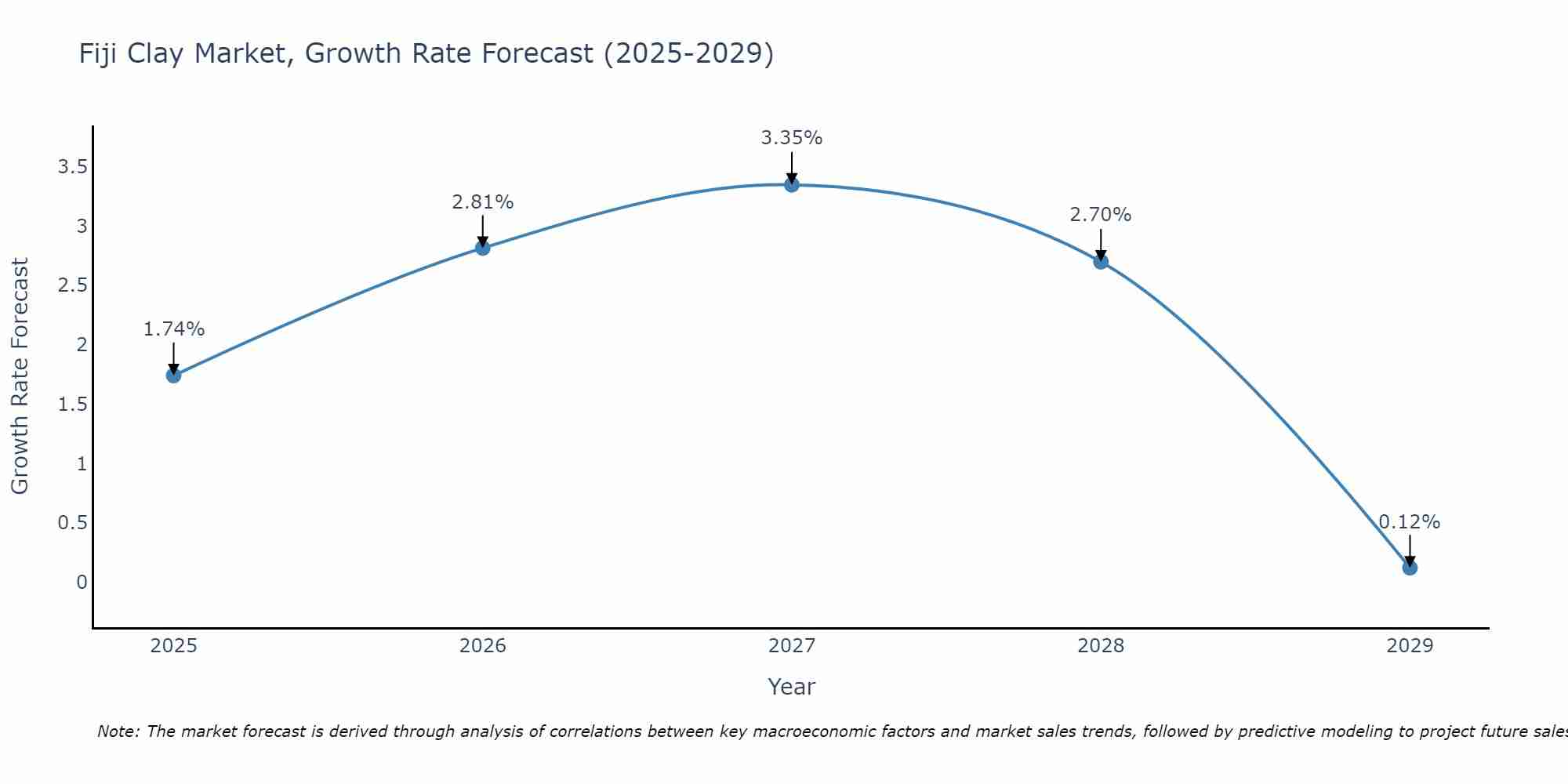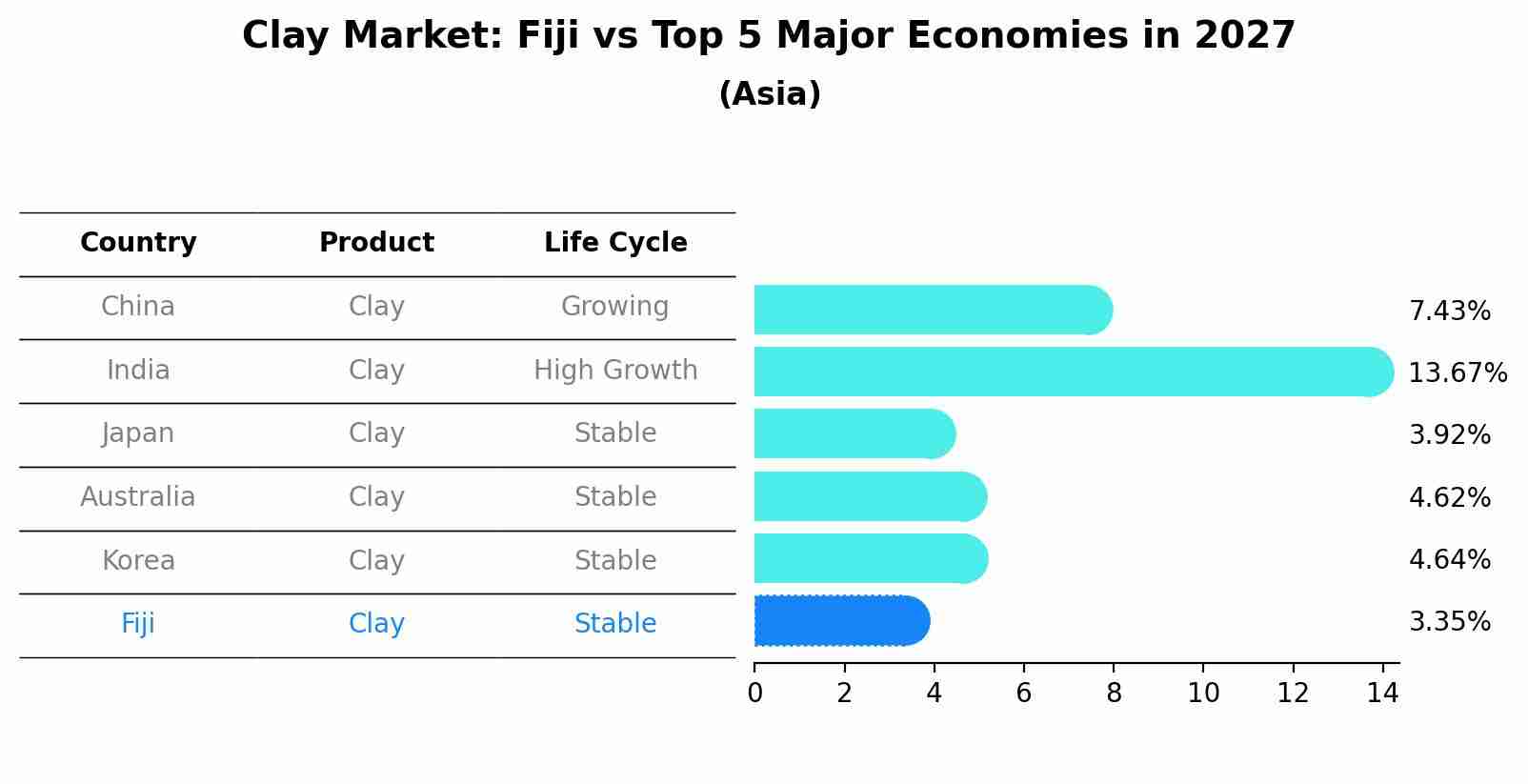Fiji Clay Market (2025-2031) | Outlook, Companies, Growth, Analysis, Trends, Industry, Segmentation, Revenue, Forecast, Value, Size & Share
| Product Code: ETC5257657 | Publication Date: Nov 2023 | Updated Date: Oct 2025 | Product Type: Market Research Report | |
| Publisher: 6Wresearch | Author: Bhawna Singh | No. of Pages: 60 | No. of Figures: 30 | No. of Tables: 5 |
Fiji Clay Market Size Growth Rate
The Fiji Clay Market is projected to witness mixed growth rate patterns during 2025 to 2029. The growth rate begins at 1.74% in 2025, climbs to a high of 3.35% in 2027, and moderates to 0.12% by 2029.

Clay Market: Fiji vs Top 5 Major Economies in 2027 (Asia)
By 2027, Fiji's Clay market is forecasted to achieve a stable growth rate of 3.35%, with China leading the Asia region, followed by India, Japan, Australia and South Korea.

Fiji Clay Market Overview
The clay market in Fiji is expanding with growing demand for raw materials in industries such as ceramics, construction, and agriculture. Clay is a versatile material used for pottery, bricks, and tiles, and as Fijis construction and manufacturing sectors grow, the demand for clay products is expected to increase.
Drivers of the market
The clay market in Fiji is growing due to its versatile applications across industries such as ceramics, construction, and agriculture. Clay is a key material in pottery, bricks, and tiles, all of which have strong demand in Fijis expanding construction sector. Additionally, clay is used in agricultural products as a soil conditioner and in various industrial applications. As Fijis economy grows, both domestic and international demand for clay-based products is expected to rise, supporting the markets expansion.
Challenges of the market
The clay market in Fiji faces challenges due to the country`s limited production of natural clay resources, which requires significant imports to meet local demand. Additionally, there is a lack of advanced processing technologies to create high-quality clay products, restricting the potential for domestic industries such as ceramics and pottery to grow. The small local market for clay-based products also limits economies of scale for producers.
Government Policy of the market
The clay market in Fiji is shaped by government policies related to agriculture, construction, and environmental protection. Clay is an important raw material in the manufacturing of ceramics, bricks, and other construction materials. Government policies that support the construction industry, infrastructure development, and the use of sustainable building materials boost the demand for clay in the construction sector. Additionally, Fijian policies promoting the sustainable extraction of natural resources and minimizing the environmental impact of mining activities influence the clay market. Trade policies regarding the importation and exportation of construction materials and raw resources also play a role in market dynamics.
Key Highlights of the Report:
- Fiji Clay Market Outlook
- Market Size of Fiji Clay Market, 2024
- Forecast of Fiji Clay Market, 2031
- Historical Data and Forecast of Fiji Clay Revenues & Volume for the Period 2021-2031
- Fiji Clay Market Trend Evolution
- Fiji Clay Market Drivers and Challenges
- Fiji Clay Price Trends
- Fiji Clay Porter`s Five Forces
- Fiji Clay Industry Life Cycle
- Historical Data and Forecast of Fiji Clay Market Revenues & Volume By Application for the Period 2021-2031
- Historical Data and Forecast of Fiji Clay Market Revenues & Volume By Tableware for the Period 2021-2031
- Historical Data and Forecast of Fiji Clay Market Revenues & Volume By Sanitary ware for the Period 2021-2031
- Historical Data and Forecast of Fiji Clay Market Revenues & Volume By Medical applications for the Period 2021-2031
- Historical Data and Forecast of Fiji Clay Market Revenues & Volume By End Use for the Period 2021-2031
- Historical Data and Forecast of Fiji Clay Market Revenues & Volume By Ceramic and for the Period 2021-2031
- Historical Data and Forecast of Fiji Clay Market Revenues & Volume By Non-ceramic for the Period 2021-2031
- Fiji Clay Import Export Trade Statistics
- Market Opportunity Assessment By Application
- Market Opportunity Assessment By End Use
- Fiji Clay Top Companies Market Share
- Fiji Clay Competitive Benchmarking By Technical and Operational Parameters
- Fiji Clay Company Profiles
- Fiji Clay Key Strategic Recommendations
Frequently Asked Questions About the Market Study (FAQs):
1 Executive Summary |
2 Introduction |
2.1 Key Highlights of the Report |
2.2 Report Description |
2.3 Market Scope & Segmentation |
2.4 Research Methodology |
2.5 Assumptions |
3 Fiji Clay Market Overview |
3.1 Fiji Country Macro Economic Indicators |
3.2 Fiji Clay Market Revenues & Volume, 2021 & 2031F |
3.3 Fiji Clay Market - Industry Life Cycle |
3.4 Fiji Clay Market - Porter's Five Forces |
3.5 Fiji Clay Market Revenues & Volume Share, By Application, 2021 & 2031F |
3.6 Fiji Clay Market Revenues & Volume Share, By End Use, 2021 & 2031F |
4 Fiji Clay Market Dynamics |
4.1 Impact Analysis |
4.2 Market Drivers |
4.2.1 Increasing demand for eco-friendly and natural skincare products |
4.2.2 Growing awareness about the benefits of using clay for skincare and wellness |
4.2.3 Rising popularity of DIY beauty treatments at home |
4.3 Market Restraints |
4.3.1 Limited availability of high-quality fiji clay due to its specific sourcing requirements |
4.3.2 Fluctuating raw material costs impacting the overall pricing of fiji clay products |
4.3.3 Competition from alternative skincare ingredients and products |
5 Fiji Clay Market Trends |
6 Fiji Clay Market Segmentations |
6.1 Fiji Clay Market, By Application |
6.1.1 Overview and Analysis |
6.1.2 Fiji Clay Market Revenues & Volume, By Tableware, 2021-2031F |
6.1.3 Fiji Clay Market Revenues & Volume, By Sanitary ware, 2021-2031F |
6.1.4 Fiji Clay Market Revenues & Volume, By Medical applications, 2021-2031F |
6.2 Fiji Clay Market, By End Use |
6.2.1 Overview and Analysis |
6.2.2 Fiji Clay Market Revenues & Volume, By Ceramic and, 2021-2031F |
6.2.3 Fiji Clay Market Revenues & Volume, By Non-ceramic, 2021-2031F |
7 Fiji Clay Market Import-Export Trade Statistics |
7.1 Fiji Clay Market Export to Major Countries |
7.2 Fiji Clay Market Imports from Major Countries |
8 Fiji Clay Market Key Performance Indicators |
8.1 Average price of fiji clay per ton |
8.2 Number of new product launches containing fiji clay |
8.3 Percentage increase in online searches for fiji clay skincare products |
9 Fiji Clay Market - Opportunity Assessment |
9.1 Fiji Clay Market Opportunity Assessment, By Application, 2021 & 2031F |
9.2 Fiji Clay Market Opportunity Assessment, By End Use, 2021 & 2031F |
10 Fiji Clay Market - Competitive Landscape |
10.1 Fiji Clay Market Revenue Share, By Companies, 2024 |
10.2 Fiji Clay Market Competitive Benchmarking, By Operating and Technical Parameters |
11 Company Profiles |
12 Recommendations | 13 Disclaimer |
- Single User License$ 1,995
- Department License$ 2,400
- Site License$ 3,120
- Global License$ 3,795
Search
Related Reports
- ASEAN and Thailand Brain Health Supplements Market (2025-2031) | Strategy, Consumer Insights, Analysis, Investment Trends, Opportunities, Growth, Size, Share, Industry, Revenue, Segments, Value, Segmentation, Supply, Forecast, Restraints, Outlook, Competition, Drivers, Trends, Demand, Pricing Analysis, Competitive, Strategic Insights, Companies, Challenges
- ASEAN Bearings Market (2025-2031) | Strategy, Consumer Insights, Analysis, Investment Trends, Opportunities, Growth, Size, Share, Industry, Revenue, Segments, Value, Segmentation, Supply, Forecast, Restraints, Outlook, Competition, Drivers, Trends, Demand, Pricing Analysis, Competitive, Strategic Insights, Companies, Challenges
- Europe Flooring Market (2025-2031) | Outlook, Share, Industry, Trends, Forecast, Companies, Revenue, Size, Analysis, Growth & Value
- Saudi Arabia Manlift Market (2025-2031) | Outlook, Size, Growth, Trends, Companies, Industry, Revenue, Value, Share, Forecast & Analysis
- Uganda Excavator, Crane, and Wheel Loaders Market (2025-2031) | Strategy, Consumer Insights, Analysis, Investment Trends, Opportunities, Growth, Size, Share, Industry, Revenue, Segments, Value, Segmentation, Supply, Forecast, Restraints, Outlook, Competition, Drivers, Trends, Demand, Pricing Analysis, Competitive, Strategic Insights, Companies, Challenges
- Rwanda Excavator, Crane, and Wheel Loaders Market (2025-2031) | Strategy, Consumer Insights, Analysis, Investment Trends, Opportunities, Growth, Size, Share, Industry, Revenue, Segments, Value, Segmentation, Supply, Forecast, Restraints, Outlook, Competition, Drivers, Trends, Demand, Pricing Analysis, Competitive, Strategic Insights, Companies, Challenges
- Kenya Excavator, Crane, and Wheel Loaders Market (2025-2031) | Strategy, Consumer Insights, Analysis, Investment Trends, Opportunities, Growth, Size, Share, Industry, Revenue, Segments, Value, Segmentation, Supply, Forecast, Restraints, Outlook, Competition, Drivers, Trends, Demand, Pricing Analysis, Competitive, Strategic Insights, Companies, Challenges
- Angola Excavator, Crane, and Wheel Loaders Market (2025-2031) | Strategy, Consumer Insights, Analysis, Investment Trends, Opportunities, Growth, Size, Share, Industry, Revenue, Segments, Value, Segmentation, Supply, Forecast, Restraints, Outlook, Competition, Drivers, Trends, Demand, Pricing Analysis, Competitive, Strategic Insights, Companies, Challenges
- Israel Intelligent Transport System Market (2025-2031) | Strategy, Consumer Insights, Analysis, Investment Trends, Opportunities, Growth, Size, Share, Industry, Revenue, Segments, Value, Segmentation, Supply, Forecast, Restraints, Outlook, Competition, Drivers, Trends, Demand, Pricing Analysis, Competitive, Strategic Insights, Companies, Challenges
- Uganda Precast and Aggregate Market (2025-2031) | Strategy, Consumer Insights, Analysis, Investment Trends, Opportunities, Growth, Size, Share, Industry, Revenue, Segments, Value, Segmentation, Supply, Forecast, Restraints, Outlook, Competition, Drivers, Trends, Demand, Pricing Analysis, Competitive, Strategic Insights, Companies, Challenges
Industry Events and Analyst Meet
Our Clients
Whitepaper
- Middle East & Africa Commercial Security Market Click here to view more.
- Middle East & Africa Fire Safety Systems & Equipment Market Click here to view more.
- GCC Drone Market Click here to view more.
- Middle East Lighting Fixture Market Click here to view more.
- GCC Physical & Perimeter Security Market Click here to view more.
6WResearch In News
- Doha a strategic location for EV manufacturing hub: IPA Qatar
- Demand for luxury TVs surging in the GCC, says Samsung
- Empowering Growth: The Thriving Journey of Bangladesh’s Cable Industry
- Demand for luxury TVs surging in the GCC, says Samsung
- Video call with a traditional healer? Once unthinkable, it’s now common in South Africa
- Intelligent Buildings To Smooth GCC’s Path To Net Zero













